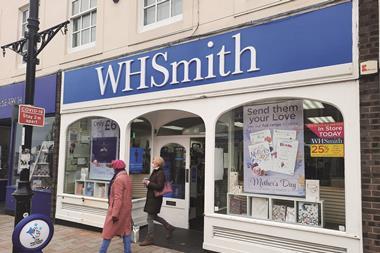The internet revolution is happening, and The Grocer will be watching and forecasting all the way. In the first of a new monthly feature tracking the future as it unfolds Belinda Gannaway assesses just how radically relationships up and down the supply chain are going to change
The internet is proving cupid, home wrecker and marriage counsellor in one. And as corporate relationships are bathed in the remorseless white light of hi-technological reassessment, it is clear the muddling through of yesteryear will never again suffice. In these days of supply chain tightening and consumer-centric strategy, it is imperative to understand the internet's impact on the relationships that sustain the food industry.
Nothing will be the same again. Old technologies are being replaced by new generations of networks and communication communities. The internet is altering how the food industry sells products, communicates brand messages, deals with suppliers and attracts investors.
A PriceWaterhouseCoopers report, The B2C Phenomenon, notes: "It will produce churn and dislocation. It will quickly create or destroy relationships and, in the process, economic value."
At the front end the sexy end that is driving multi-million pound flotations of the scale of lastminute.com the internet is the lifeblood of new and the destroyer of old ties between retailers and consumers.
Not every consumer will be an online shopper but those ever larger retailers that survive these turbulent times will need to be both e-tailer and retailer.
But today's scattergun approach to attracting online custom is not good enough. To make money, retailers need to target the segments of the market they can supply regularly, in bulk, and at a profit.Regular orders will keep down the cost of customer acquisition.
Selling online requires a new set of relationship management skills. The bond with the consumer will be the most valuable business asset around.
PriceWaterhouseCoopers notes: "Almost nothing matters except who owns the relationship with consumers. We are clearly in a battle for relationships. E-business facilitates the creation of new value propositions that are beginning to provide consumers with compelling reasons to form new relationships."
And as the supermarkets tell us, value is not solely about price. But neither is shopping online a simple response to the negatives of shopping on foot.
E-tailing needs to offer a whole new shopping experience. Buying online is not just about shopping, it's about entertainment. Why would consumers replace one drudge factor with another, even if it is from the comfort of the sitting room? Big retail brands of the future will be a complex mix of product, service and entertainment. Online branding is all about getting the largest possible share of consumer consciousness.
And the provision of groceries will not be restricted to the supermarkets. There is nothing to stop a megaportal providing the front end for sourcing cheap household goods online, cutting through the noise and becoming a one stop-multishop in cyberland. And it may well not have the usual suspect's name above the cyberdoor.
PriceWaterhouseCoopers notes: "[Companies] want to own a whole segment of the consumer's life and a whole chunk of his or her spending. They're not interested in share of market or share of category. They're interested in share of life.
"The customer relationship management skills that will be required to successfully capitalise on these relationships are of an order of magnitude more sophisticated than those found in most businesses today."
So the consumer is driving what companies are doing on the net; here is the Henley Centre's concept of a new bottom up world'. Gone are the days of big business, religion, monarchy and government dictating to the masses. Issue groups, consumer power and spirituality are the new leaders. Consumers will no longer be told what to buy, they are dictating what companies sell, at what price, and where. And consumers want commerce at the speed of life.
Take Priceline in the US where shoppers go online to set the price they want to pay for everything from groceries to airline tickets and hotel rooms. In the grocery business for five months, Priceline has more than 250,000 customers in the north east and has sold more than 10 million items.
With online shopping more entrenched in the US, grocers are stepping up price cuts and incentive programmes to encourage online loyalty. The end of the suggested selling price is well and truly nigh as the internet renders traditional pricing modes obsolete. In New York City national provider Netgrocer claims to be 20% cheaper than the average supermarket basket.
Pricing is a strategic weapon long employed by airlines and ticket touts. Price discrimination will take off on the internet as and when e-tailers gain a shrewd grasp of online customer behaviour patterns.
A recent survey by Cisco and Oracle found that 80% of UK retailers admit to making strategic decisions based upon poor quality information. Some 24% believe their customer data is inaccurate and more than a third say it is more than five days old or are unsure of its age.
The ability to retrieve, analyse and act on customer information will become cheaper and quicker as online sales grow. The competitive edge will shift to those best placed to act upon that information hence speed, not size, will determine success on the net.
The internet gives retailers far more scope for tracking individual consumer behaviour and communicating with them on an individual basis.
The key is maximising that communication potential electronic receipts via e-mail are just one avenue and leveraging it to fit individual needs. The challenge will be achieving that while avoiding any sense of infringement of individual privacy.
But it's not just retailers that are in need of relationship counselling. Harnessing the reach and interactivity of the internet to build and leverage brands is just as critical for suppliers. It's the best chance they've got of recapturing some of the power that has shifted to retailers. It's a different way of dealing with their audience, an opportunity for greater dialogue with their consumer, providing a meaningful dialogue, even a two way dialogue.
E-tailing is, furthermore, changing the nature of the manufacturer/consumer interface.
In the US Netgrocer president Fred Horowitz believes new opportunities for brand owners have been underrated: "This is the greatest opportunity to rebuild a brand. But whenever there's an opportunity there's also the chance to screw it up.
"This is the hour they can take away the pricing umbrella of own label built upon the fact they're paying the supermarkets for slotting and they're paying for outrageous couponing prices, which are all about switching and loyalty.
"Once a particular cookie or shampoo is on our shopping list and we can convince that customer to put in five future orders over the next six months, we can go back to the manufacturer and say look, we've just got you a loyal customer, what's that worth to you? And we then give that saving right back to the customer."
Netgrocer works with branded goods manufacturers to maximise what Horowitz calls the "utilities" of brands in the Netgrocer store. Kraft has a monthly meal planner with recipes using its products. One click and the products go in your basket. "We've given brand owners a way to create actionable content, and that's very powerful," Horowitz says.
But not all e-tailing models are so brand friendly. With Priceline, shoppers cannot specify a brand or size. They are asked to select at least two or three different brands.
Priceline, though, is only one example of the multitude of new industry marketplaces facilitated by the internet.
The organisational bunker mentality is disappearing. From purchasing to human resources, traditionally insular business functions are being replaced by new communities and conversations.
And retailers and manufacturers alike are joining together to cash in on the benefits of online sourcing and supply. Auction sites have turned the internet into a global flea market. And the benefits go both ways. The vendor has the opportunity to get the best price while offering a host of quality and cost information, while the purchaser gets the best deal on any table anywhere in the world.
Last month 50 large US food, drink and fmcg manufacturers joined the Grocery Manufacturers of America to launch a new electronic marketplace accessible to all supply players in what is described as a "dynamic, collborative global trading network".
European players Nestlé and Danone have joined forces to launch CPGmarket.com Europe's first net marketplace for buying goods and services and hope to link up with its US competition [The Grocer, March 25, p13].
A further venture, eFoodmanager, to be launched in May, will connect thousands of European food suppliers with retail buyers as well as armies, restaurants and hotel chains. It aims to snatch a 10% slice or £500m share of the business to business food market by 2003. Joint md Jan Stenger says the business will offer European food suppliers a global marketplace and cut costs by up to 30%.
On the flip side, retailers, too, are forming online exchanges. Sears and Carrefour have teamed up with Sainsbury and Metro to form GlobalNetXchange. The four equity partners have a combined annual buying clout of more than $140bn covering more than 50,000 suppliers. The business could float in 18 months.
Sainsbury chief executive Sir Peter Davis described it as an "innovative and revolutionary step change in the way retailers and suppliers will conduct their business worldwide". He added: "The benefits and efficiencies generated by this initiative will have significant impact across all aspects of our business and create new value for our customers."
Such initiatives are winning the retail sector some positive press. E-tailing is one of the most talked about segments of the new economy, and that can only be good news for the industry's continuing drive to attract investment and high calibre recruits.
But switching on to the new economy isn't about buying a few vans and sticking an e in front of what is essentially a glorified catalogue home shopping operation. Becoming an e-business is as much about the business as the e. The winners will be those that are fast, not, for once, those that are big. And there will be losers. Sometimes you've got to run pretty close to the bleeding edge to be on the leading edge. n
{{COVER FEATURE }}
Close menu
- Home
- Retail & Wholesale
-
Products & Suppliers
- Back to parent navigation item
- Products & Suppliers
-
Product Categories:
- Back to parent navigation item
- Product Categories:
- Alcoholic drinks
- Bakery
- Cereals & breakfast
- Cheese
- Chicken & poultry
- Chocolate
- Confectionery
- Crisps, nuts & snacks
- Dairy
- Fish
- Fresh produce
- Frozen
- Household
- Meat
- Own Label
- Sauces & condiments
- Seasonal
- Soft drinks
- Vaping
- Vegan & plant-based
- World foods
- Suppliers
- People
- Reports & Data
-
Topics A-Z
- Back to parent navigation item
- Topics A-Z
-
Popular topics:
- Back to parent navigation item
- Popular topics:
- Cost of living crisis
- Crime
- Deposit Return Schemes
- Finance
- Government & Regulation
- Health
- Inflation
- Loyalty
- Marketing
- Mergers & Acquisitions
- New Product Development
- Sourcing
- Supply chain
- Sustainability & environment
- Technology
- Ultra Processed Foods
- Vaping
- A-Z all topics
- Content by type:
- Events
- Ask iA (beta)
- Subscribe now
Sign in to comment on this article
Not logged in before? Register for FREE guest access today.
You will be able to:
- Read more stories
- Receive daily newsletters
- Comment on stories
Advert















No comments yet